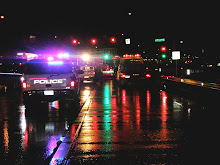As I knelt onto the wet flagstone behind the unresponsive, laid-out stranger's head, I grasped the angle of his jaw with my fingertips and jut it forward to try to relieve some of his comatose snoring. His pupils pointlessly fixated on the sky above my head and foam dribbled out of his mouth... his wife confirmed that he was diabetic and had been having trouble with his sugar lately.
The rest of the crew worked in that freaky lightning fast synchronized dance... the paramedic set up a line as the firefighter/EMT tested his sugar. The engineer handed the D50 to the medic and as soon as the EMT confirmed that the man's blood glucose level was ridiculously low, the medic was pushing the D50.
They had me hand over my jaw thrust and grab a manual BP and by the time I had the cuff on he was coming out of it as evidenced by his sudden confused glances. The medic, his wife and I reassured him but he quickly understood what was going on. He knew his name, the time, and that he had been feeling pretty low on sugar when he came out into the backyard, but didn't remember falling or seizing.
The medic checked out his head, neck and back. He encouraged the man to take a ride to the ER, but unsurprisingly he refused. He was pretty much totally fine, just a little loopy. The wife brought the man some cheese and bread and orange juice as we sat and talked with them for a while. It was almost like a pleasant visit, the dog came out and the guys from the crew played fetch with him. About 5-10 minutes after the man had recovered from his comatose state I rechecked the man's BGL, the medic called in the refusal on the biophone, and we left.
What an amazing thing to witness - it's an exceedingly rare occurrence that EMS can go above and beyond stabilizing someone long enough to get them to the hospital. To bring someone from a completely unresponsive and dangerous state back to normal... it makes me excited about expanding my scope of practice and gaining the experience to make those tools useful.
Subscribe to:
Post Comments (Atom)


4 comments:
After working in the hospital and then flying, it was so strange to experience this and not transport. Amazing to bring someone back and not have it be a lights and sirens moment.
I love the D50 its like Magic....as Emily said "bring someone back" it rocks
from my experience this is a very common call. I would say we do this at least a couple times a week. If you really want to see something cool watch NARCAN being used on an apneic herion OD. They go from not breathing, to telling you they don't do drugs. I once put a NPA in such a patient, when he came to, he told me he had just fallen asleep on the floor. So I asked if he normally stops breathing when he is sleeping, then I asked how he got the tube in his nose. He said "what tube?" Anyway D50 is a very cool drug. JS
Other drugs have a rapid response similar to D50 and naloxone (which is NOT selective for opiates).
CPAP and nitroglycerin for acute hypertensive exacerbations of CHF can be dramatic in their effect.
Adenosine, cardioversion, and defibrillation can cause immediate reversal of the patient condition.
When it comes to calming patients down, appropriate doses of fentanyl for pain and midazolam for sedation work pretty well.
Post a Comment